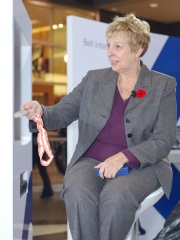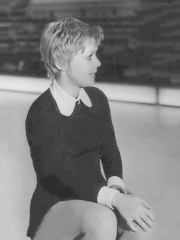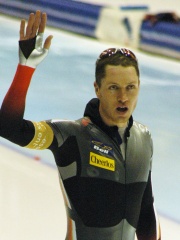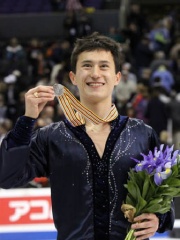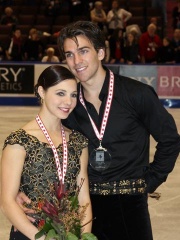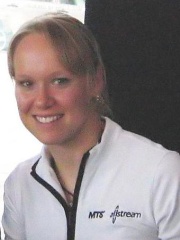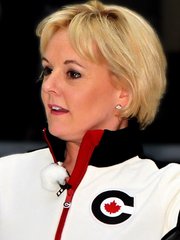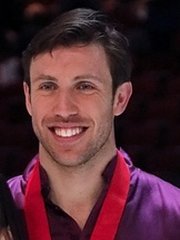
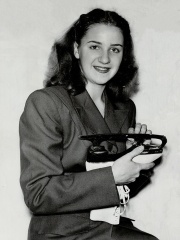

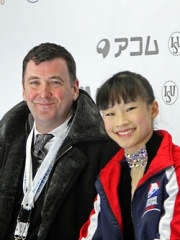


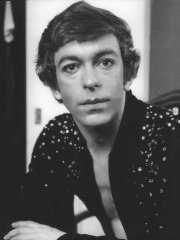
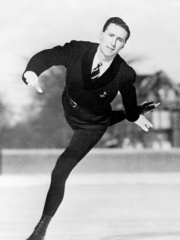
The Most Famous
SKATERS from Canada
This page contains a list of the greatest Canadian Skaters. The pantheon dataset contains 483 Skaters, 50 of which were born in Canada. This makes Canada the birth place of the 4th most number of Skaters behind United States, and Netherlands.
Top 10
The following people are considered by Pantheon to be the top 10 most legendary Canadian Skaters of all time. This list of famous Canadian Skaters is sorted by HPI (Historical Popularity Index), a metric that aggregates information on a biography's online popularity. Visit the rankings page to view the entire list of Canadian Skaters.

1. Donald Jackson (b. 1940)
With an HPI of 59.79, Donald Jackson is the most famous Canadian Skater. His biography has been translated into 17 different languages on wikipedia.
Donald George Jackson (born April 2, 1940) is a Canadian retired figure skater. He is the 1962 World Champion, four-time Canadian national champion, and 1960 Olympic bronze medallist. At the 1962 World Figure Skating Championships in Prague, Czechoslovakia, he landed the first triple Lutz jump in international competition and won the world title.

2. Suzanne Morrow Francis (1930 - 2006)
With an HPI of 59.40, Suzanne Morrow Francis is the 2nd most famous Canadian Skater. Her biography has been translated into 18 different languages.
Suzanne Morrow Francis (December 14, 1930 – June 11, 2006) was a Canadian figure skater and veterinarian. She competed in Ladies' Singles in the 1948 and 1952 Winter Olympics. Between 1947 and 1948, Francis competed in Pairs Mixed competitions with Canadian figure skater Wallace Diestelmeyer. Together they won the bronze medal at the 1948 Winter Olympics and the 1948 World Figure Skating Championships. They were the first pair team to perform the death spiral one-handed, with the man holding the woman in position with one hand, at the 1948 Olympic Games.

3. Robert Paul (1937 - 2024)
With an HPI of 59.20, Robert Paul is the 3rd most famous Canadian Skater. His biography has been translated into 19 different languages.
Robert Paul (June 2, 1937 – December 19, 2024) was a Canadian pair skater. He teamed up with Barbara Wagner in 1952. They became the 1960 Olympic champions, four-time World champions, and five-time Canadian national champions. After retiring from competition, the pair toured with Ice Capades.

4. Brian Orser (b. 1961)
With an HPI of 56.09, Brian Orser is the 4th most famous Canadian Skater. His biography has been translated into 23 different languages.
Brian Ernest Orser OLY (born 18 December 1961) is a Canadian former competitive and professional figure skater and coach to Olympic champions. He is the 1984 and 1988 Olympic silver medallist, 1987 World champion and eight-time (1981–88) Canadian national champion. At the 1988 Winter Olympics, the rivalry between Orser and American figure skater Brian Boitano, who were the two favorites to win the gold medal, captured media attention and was described as the "Battle of the Brians". Orser turned professional in 1988 and skated with Stars on Ice for almost 20 years. As a coach, he has led both Yuna Kim (2010) and Yuzuru Hanyu (2014, 2018) to Olympic titles. He also coached Javier Fernández to Olympic bronze (2018) and the 2015 and 2016 World titles. He is a Skating Consultant at the Toronto Cricket Skating and Curling Club.
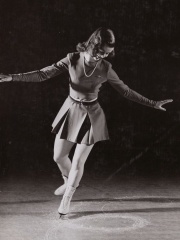
5. Barbara Ann Scott (1928 - 2012)
With an HPI of 55.95, Barbara Ann Scott is the 5th most famous Canadian Skater. Her biography has been translated into 25 different languages.
Barbara Ann Scott (May 9, 1928 – September 30, 2012) was a Canadian figure skater. She was the 1948 Olympic champion, a two-time World champion (1947–1948), and a four-time Canadian national champion (1944–46, 48) in ladies' singles. Known as "Canada's Sweetheart", she is the only Canadian to have won the Olympic ladies' singles gold medal, the first North American to have won three major titles in one year and the only Canadian to have won the European Championship (1947–48). During her forties she was rated among the top equestrians in North America. She received many honours and accolades, including being made an Officer of the Order of Canada in 1991 and a member of the Order of Ontario in 2008.

6. Barbara Wagner (b. 1938)
With an HPI of 54.56, Barbara Wagner is the 6th most famous Canadian Skater. Her biography has been translated into 19 different languages.
Barbara Aileen Wagner (born May 5, 1938) is a Canadian former pair skater. She teamed up with Robert Paul in 1952. They became the 1960 Olympic champions, four-time World champions, and five-time Canadian national champions. After retiring from competition, the pair toured with Ice Capades. Wagner was formerly married to U.S. figure skater James Grogan. She resides in Alpharetta, Georgia, coaching figure skating at the Alpharetta Family Skate Center, the Cooler, and is a member of the Atlanta Figure Skating Club.

7. Alexander Hurd (1910 - 1982)
With an HPI of 54.51, Alexander Hurd is the 7th most famous Canadian Skater. His biography has been translated into 16 different languages.
Alexander Brengle Hurd (July 21, 1910 – May 28, 1982) was a Canadian speed skater and Olympic medalist. He won a silver medal and a bronze medal at the 1932 Winter Olympics in Lake Placid.

8. Toller Cranston (1949 - 2015)
With an HPI of 52.96, Toller Cranston is the 8th most famous Canadian Skater. His biography has been translated into 18 different languages.
Toller Shalitoe Montague Cranston (April 20, 1949 – January 24, 2015) was a Canadian figure skater and painter. He won the 1971–1976 Canadian national championships, the 1974 World bronze medal and the 1976 Olympic bronze medal. Despite never winning at the World Figure Skating Championships due to his poor compulsory figures, he won the small medal for free skating at the 1972 and 1974 championships. Cranston is credited by many with having brought a new level of artistry to men's figure skating.

9. Montgomery Wilson (1909 - 1964)
With an HPI of 52.34, Montgomery Wilson is the 9th most famous Canadian Skater. His biography has been translated into 18 different languages.
William Stewart Montgomery "Bud" Wilson (August 20, 1909 – November 15, 1964) was a Canadian figure skater. Competing in singles, he became the 1932 Olympic bronze medallist, the 1932 World silver medallist, a six-time North American champion, and a nine-time Canadian national champion.
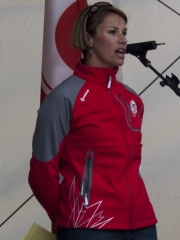
10. Catriona Le May Doan (b. 1970)
With an HPI of 48.80, Catriona Le May Doan is the 10th most famous Canadian Skater. Her biography has been translated into 23 different languages.
Catriona Ann Le May Doan, (born December 23, 1970) is a retired Canadian speed skater and a double Olympic champion in the 500 m. She served as the chef de mission for Team Canada at the 2022 Winter Olympics in Beijing.
People
Pantheon has 50 people classified as Canadian skaters born between 1909 and 1998. Of these 50, 44 (88.00%) of them are still alive today. The most famous living Canadian skaters include Donald Jackson, Brian Orser, and Barbara Wagner. The most famous deceased Canadian skaters include Suzanne Morrow Francis, Robert Paul, and Barbara Ann Scott. As of April 2024, 10 new Canadian skaters have been added to Pantheon including Sylvie Daigle, Elizabeth Manley, and Isabelle Brasseur.
Living Canadian Skaters
Go to all RankingsDonald Jackson
1940 - Present
HPI: 59.79
Brian Orser
1961 - Present
HPI: 56.09
Barbara Wagner
1938 - Present
HPI: 54.56
Catriona Le May Doan
1970 - Present
HPI: 48.80
Debbi Wilkes
1946 - Present
HPI: 48.11
Karen Magnussen
1952 - Present
HPI: 45.80
Sylvie Daigle
1962 - Present
HPI: 45.71
Jeremy Wotherspoon
1976 - Present
HPI: 44.84
Patrick Chan
1990 - Present
HPI: 44.82
Jessica Dubé
1987 - Present
HPI: 44.70
Cindy Klassen
1979 - Present
HPI: 43.97
Tessa Virtue
1989 - Present
HPI: 43.90
Deceased Canadian Skaters
Go to all RankingsSuzanne Morrow Francis
1930 - 2006
HPI: 59.40
Robert Paul
1937 - 2024
HPI: 59.20
Barbara Ann Scott
1928 - 2012
HPI: 55.95
Alexander Hurd
1910 - 1982
HPI: 54.51
Toller Cranston
1949 - 2015
HPI: 52.96
Montgomery Wilson
1909 - 1964
HPI: 52.34
Newly Added Canadian Skaters (2025)
Go to all RankingsSylvie Daigle
1962 - Present
HPI: 45.71
Elizabeth Manley
1965 - Present
HPI: 38.83
Isabelle Brasseur
1970 - Present
HPI: 36.43
Pascal Dion
1994 - Present
HPI: 33.92
Lucas Makowsky
1987 - Present
HPI: 33.76
Ivanie Blondin
1990 - Present
HPI: 33.33
Charle Cournoyer
1991 - Present
HPI: 32.30
Dylan Moscovitch
1984 - Present
HPI: 31.88
Kirsten Moore-Towers
1992 - Present
HPI: 27.80
Jessica Gregg
1988 - Present
HPI: 27.52
Overlapping Lives
Which Skaters were alive at the same time? This visualization shows the lifespans of the 6 most globally memorable Skaters since 1700.

